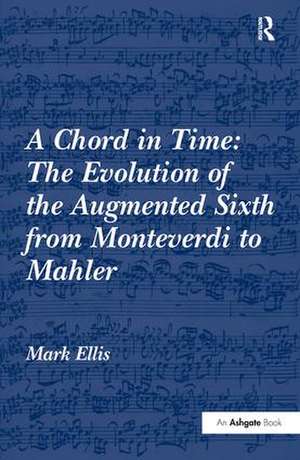A Chord in Time: The Evolution of the Augmented Sixth from Monteverdi to Mahler
Autor Mark Ellisen Limba Engleză Hardback – 28 apr 2010
| Toate formatele și edițiile | Preț | Express |
|---|---|---|
| Paperback (1) | 489.26 lei 6-8 săpt. | |
| Taylor & Francis – 9 sep 2016 | 489.26 lei 6-8 săpt. | |
| Hardback (1) | 1061.06 lei 6-8 săpt. | |
| Taylor & Francis – 28 apr 2010 | 1061.06 lei 6-8 săpt. |
Preț: 1061.06 lei
Preț vechi: 1293.97 lei
-18% Nou
Puncte Express: 1592
Preț estimativ în valută:
203.06€ • 220.49$ • 170.57£
203.06€ • 220.49$ • 170.57£
Carte tipărită la comandă
Livrare economică 22 aprilie-06 mai
Preluare comenzi: 021 569.72.76
Specificații
ISBN-13: 9780754663850
ISBN-10: 075466385X
Pagini: 268
Dimensiuni: 156 x 234 x 16 mm
Greutate: 0.64 kg
Ediția:1
Editura: Taylor & Francis
Colecția Routledge
Locul publicării:Oxford, United Kingdom
ISBN-10: 075466385X
Pagini: 268
Dimensiuni: 156 x 234 x 16 mm
Greutate: 0.64 kg
Ediția:1
Editura: Taylor & Francis
Colecția Routledge
Locul publicării:Oxford, United Kingdom
Cuprins
Contents: Preface; Key concepts; Natural selection; Painted words; Harmony and invention; The augmented 6th in Bach's music; The science of composition; Classical contexts; Triumph and ambiguity; Swansong; Bibliography; Index.
Descriere
For centuries, the augmented sixth sonority has fascinated composers and intrigued music analysts. Here, Dr Mark Ellis presents a series of musical examples illustrating the 'evolution' of the augmented sixth and the changing contexts in which it can be found. Surprisingly, the chord emerged from one of the last remnants of modal counterpoint to survive into the tonal era: the Phrygian Cadence. This book will appeal to music analysts by providing a chronological framework for further stylistic and harmonic analysis. To ensure its accessibility in graduate classes, the author provides a straightforward introduction to the augmented sixth and its theoretical background. The book concludes with a discussion of the role of the chord in the decay of the tonal system, and its 'afterlife' in the post-tonal era.
Notă biografică
Mark Ellis teaches Music Theatre at Kirklees College, and Harmony and Analysis at Huddersfield University, UK.





















